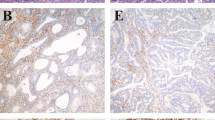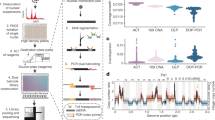Abstract
Microsatellite instability is a form of genetic damage that may be due to defective mismatch repair genes and may be a marker of processes leading to malignancy. We have analysed a series of epithelial hyperplasia of usual type, carcinomas in situ and invasive and metastatic carcinomas from the mammary gland on the assumption that they represent stages in the evolution of mammary carcinoma. Eight markers on chromosomes 3p, 4q, 9p, 11p, 14q, 17p, 17q and Xq were examined for microsatellite instability and loss of heterozygosity. High rates of loss on chromosomes 17p, 17q and Xq indicate that these chromosomal arms contain genes important in mammary carcinogenesis. The rate of microsatellite instability observed in this study was uniformly low, irrespective of the lesion. This implies that microsatellite instability is not a marker of malignancy in most instances of mammary neoplasia.
This is a preview of subscription content, access via your institution
Access options
Subscribe to this journal
Receive 24 print issues and online access
$259.00 per year
only $10.79 per issue
Buy this article
- Purchase on Springer Link
- Instant access to full article PDF
Prices may be subject to local taxes which are calculated during checkout
Similar content being viewed by others
Author information
Authors and Affiliations
Rights and permissions
About this article
Cite this article
Dillon, E., de Boer, W., Papadimitriou, J. et al. Microsatellite instability and loss of heterozygosity in mammary carcinoma and its probable precursors. Br J Cancer 76, 156–162 (1997). https://doi.org/10.1038/bjc.1997.357
Issue Date:
DOI: https://doi.org/10.1038/bjc.1997.357
This article is cited by
-
The expression of mismatched repair genes and their correlation with clinicopathological parameters and response to neo-adjuvant chemotherapy in breast cancer
International Seminars in Surgical Oncology (2007)
-
Genetic Heterogeneity in Ductal Carcinoma of the Breast
Laboratory Investigation (2000)
-
Analysis of BRCA1 involvement in breast cancer in Indian women
Journal of Biosciences (2000)



